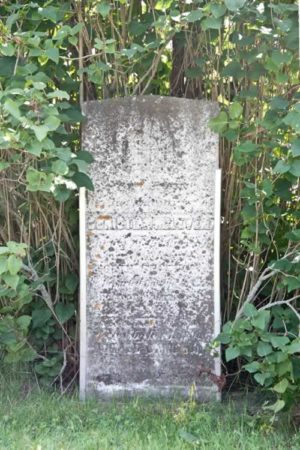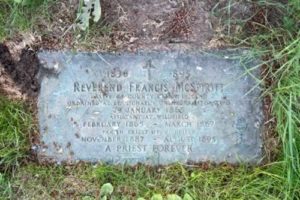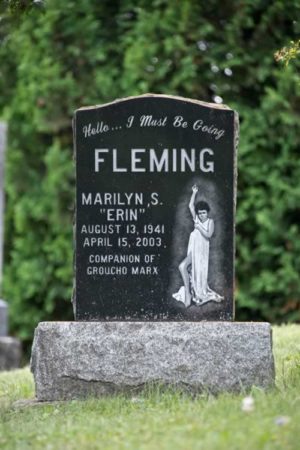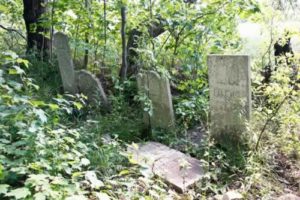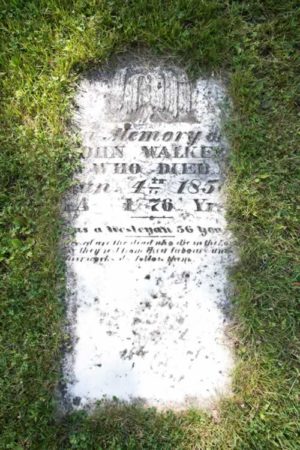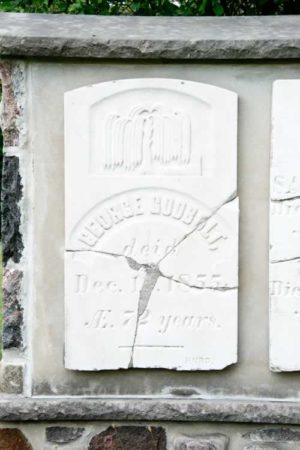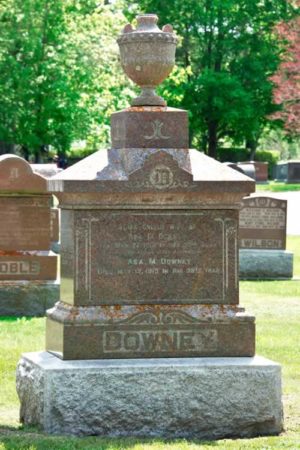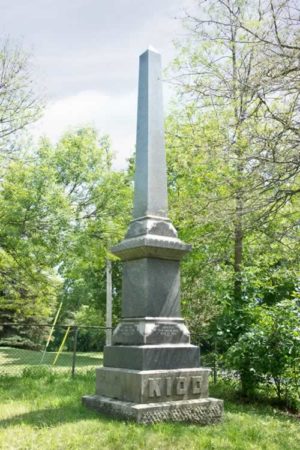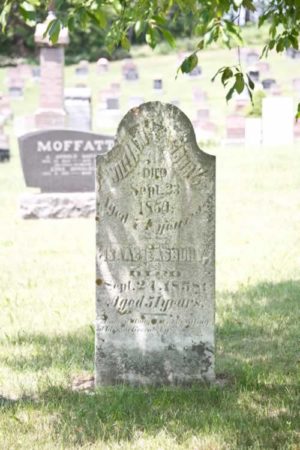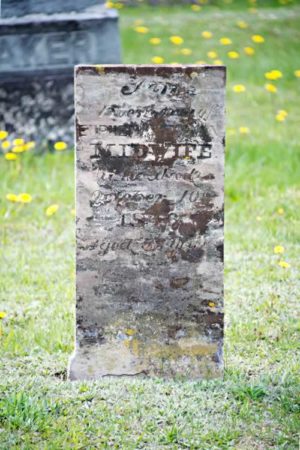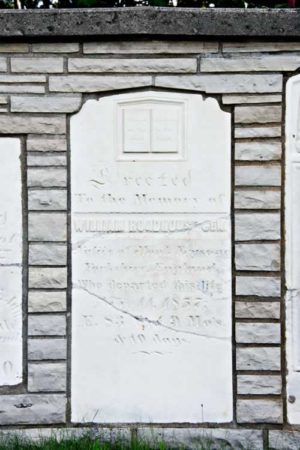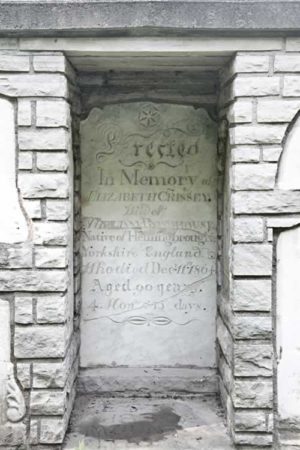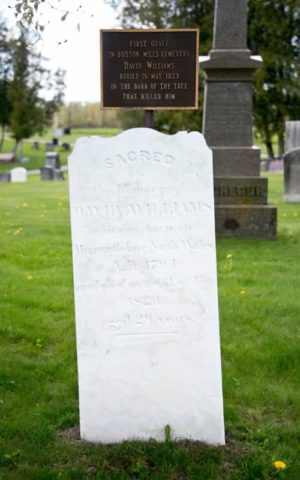Stories in the Stones
Murder, Hollywood intrigue and heroic deaths are among the tales that lurk on tombstones in cemeteries from Bolton to Horning’s Mills.
In the cemeteries across these hills, there are gravestones with remarkable stories to tell. Here are some of them.
NOT JUST ANY HALLOWED GROUND
Hugh Matson (1792–1863)
Anglican Burying Ground
(within Laurel Cemetery), Bolton
The pallbearers at Hugh Matson’s funeral in late March 1863 faced a mighty task. The wake was in Palgrave; the grave was 10 kilometres south in Bolton, and the burden would be on their shoulders the entire way because neither horse nor oxen could pull a load down the narrow, muddy trail that one day would be Highway 50. On the way, they would pass two cemeteries. Both were Methodist though, and eternity for Hugh had to be met in an Anglican burying ground.
Heavy rain not only made the journey difficult for the bearers, it also leached the dye from the undertaker’s funeral capes, turning their clothes purple. And they had to bail out Hugh’s grave! It was full of water. For these men it was a long and exhausting day, but they would have had comfort in knowing their friend was now in the hallowed ground of his choice. He would have done the same for them.
Bolton’s Anglican Burying Ground was closed in 1925 and like many pioneer cemeteries went into decline. It was rehabilitated in 1972. Typically in this process, the bodies are left undisturbed and whatever stones that can be located are remounted in cairn walls. Hugh Matson’s original stone was not included in the new cairn. Along with several Matson children who died in the late 19th century, Hugh was reinterred in adjacent Laurel Cemetery c.1934, where he (with his spouse) is memorialized on a modern granite stone.
A STORY WITHOUT A STONE
Mary Wilkins (1840−1878)
Wellington County House of Industry and Refuge
Mary Wilkins was taken into the House of Industry and Refuge against her will on December 26, 1878. “The Poorhouse,” as it was commonly known, was not a prison, but it had strict rules and on a bitterly cold night Mary escaped. She’d been there only two days. Her getaway was successful, but the following April her frozen body was found on a nearby farm. Mary’s remains were stored in an empty shed to await an inquest, but they mysteriously disappeared and local doctors were suspected of body snatching.
Acquiring a skeleton for the office by first acquiring a body was not unheard of in the Victorian era, and because most of the stolen bodies were those of indigents or with dubious histories, investigations into body snatching were not a priority. Mary, regrettably, was an ideal candidate for she had been officially determined to be of “loose character” and was suspected of having venereal disease. At the inquest in Fergus, the jury, along with the local press, came to unflattering conclusions about Mary and no further effort was made. Her body was never found and no one was ever charged with stealing it.
NOT TO BE FORGOTTEN – EVER
John Kidd (1798−1895)
Kidd Family Vault, Mono Mills
Reaching age 97 was unusual in the 19th century and that achievement alone would have attracted attention to John Kidd, but this successful innkeeper wasn’t leaving his memory to chance. Besides arranging for a lofty monument (at about 7 metres it is one of the tallest private stones in Ontario), Kidd had a grand vault for himself dug into a hill. Lest that escape notice, he commissioned a glass-lidded coffin that he displayed in his inn for years prior to his death – an event he managed to highlight by marrying 16-year-old Gertie Robins when he had, as it turned out, just six months left.
Gertie attained fame of her own by deserting the marriage, winning a $5,000 lawsuit from Kidd’s estate, and then leaving for parts unknown with a new husband. She was soon forgotten. Kidd’s memory is preserved in stone.
ONE STONE, TWO SIDES, TWO STORIES
William Roadhouse Sr. (1774−1857)
& Elizabeth (Crissey) Roadhouse (1774−1864)
Mt. Pleasant Pioneer Cemetery, Caledon
In 1830, William Roadhouse Sr. set aside a piece of his pioneer farm for a burial ground. In 1842, he deeded the site to the Wesleyan Methodist Church, and when he died in 1857, his marker was rightly given a place of prominence. In the 1970s, with the cemetery long in decline, William’s stone was taken away for repairs and forgotten. Its discovery in 1998 – under straw in an unused barn in King Township – together with William’s stature as one of the first settlers in Albion Township led to a rehabilitation of the cemetery and construction of a cairn wall with his stone once again in a position of prominence.
The memorial details of his wife, Elizabeth Crissey, were engraved on the other side of the stone when she was buried beside her husband in 1864, thus posing a problem for the construction of the cairn wall. Typically, retrieved gravestones are set in concrete in the wall. For this unique husband and wife stone, the contractor (male) decided that William, as the allegedly more significant deceased, would face outward, which meant burying Elizabeth’s memorial in the concrete. The heritage officer (female) overseeing the project learned of this just in time, so that today Elizabeth’s memorial can be seen in a special inset on the obverse of the cairn wall. William and Elizabeth thus remain together, equally memorialized for all to see.
“WILFULLY SHOT WHILE SITTING AT HIS OWN FIRESIDE”
Isaac Easbury (1807−1858)
Old St. John’s Cemetery, Mono
The grave and the stone belong to Isaac Easbury. The story he shares with John Irwin. The inscription says, “I.E was wilfully shot while sitting at his own fireside by …” and everyone in Mono Township just knew the “by …” referred to Irwin. He had been aggressively courting Isaac’s mother, Lydia, a much older woman (with property), and Isaac was strongly opposed to the match.
The constabulary agreed with prevailing opinion and laid a murder charge against Irwin, but it was dismissed at trial for lack of evidence. Still, events over the next two years did little to restore his reputation. He married Lydia almost immediately after the acquittal, and within a few months, title to her property passed into his hands. A few more months passed and Lydia died in circumstances mysterious enough for her stomach contents to be sent to Toronto to be analyzed for poison. Irwin was again suspected, but results were negative and he was not charged.
Lydia was buried beside Isaac on August 26, 1861. Irwin did not attend the ceremony.
HOLLYWOOD IN HORNING’S MILLS
Erin Fleming (1941–2003)
Horning’s Mills Cemetery
To movie buffs, “Hello … I must be going” is a famous line from a famous 1930 Groucho Marx movie, Animal Crackers. Erin Fleming became known because of her connection to Groucho.
Marilyn “Erin” Fleming was born in New Liskeard and left for Hollywood to become a star. Her acting career, despite a few notable roles (one in a Woody Allen movie) was modest, but she achieved status in Hollywood through her involvement with Groucho. He was nearly 80 when Erin, some 50 years younger, became his companion and agent.
Although she is credited with briefly reviving Groucho’s career, Erin was headline fodder for the tabloids, especially after he died in 1977 and she was accused of abuse and fraud. The case made her famous, but her career was irreparably harmed. She eventually became homeless and died by her own hand in Los Angeles.
The Fleming family name on stones in the cemetery at Horning’s Mills suggests why Erin is memorialized here. Groucho’s pet phrase on her stone suggests that the family, like many who knew her, accepts that her connection with Marx was caring and genuine.
HEROISM CLOAKED IN IRONY
Asa Downey (1877−1915)
Laurel Cemetery, Bolton
Getting a team of horses and loaded wagon down Bolton’s steep north hill was always a risky business, so Asa Downey, a 38-year-old widower with his young son aboard, was concentrating on the task as he edged his team down to McFall’s mill – until there was a noise behind him no farmer ever wanted to hear. A runaway team was galloping down the hill, pulling a wagon with children aboard. Instinctively, Asa jumped off his own wagon to prevent a sure disaster but tripped and fell under the runaways. Seconds later the frenzied horses reached the bottom of the hill and because the mill was a familiar destination they simply stopped there as they had many times before. The wagon was intact and the passengers, although completely terrified, were unharmed. Asa lay up on the hill. His injuries had been fatal.
DID SPELLING COUNT?
George Godbolt (1783−1855)
Godbolt Family Cemetery, Caledon
If this stone could talk, “deid” might be the first story to be explained. English spelling was pretty much standardized well over a century before George Godbolt died, so this seems to be a typo set in stone. Still, George’s name is spelled correctly and that was not always a certainty in his time. In a graveyard not far from this one, 12 members of one family (neighbours of George) are commemorated in three different spellings: Wolfe, Woulfe and Wolf.
George Godbolt is buried in a family cemetery along with his wife, Rachel Bolton (1787−1868), and four extended family members on land he acquired and farmed c.1840. There are more than a few small, intimate cemeteries like this one in the hills, some established before church-based burying grounds were available, others because a family chose to do so.
A FINAL LOVING ACT
Christian (McLeven) Cameron (1794−1823)
St. Andrew’s Stone Church, Caledon
In March 1821, Donald and Christian Cameron spent their first night in Caledon in a snowbank. They wrapped themselves in sailcloth with their two-year-old cuddled between them. They slept that way each night for two weeks until they could build a crude, doorless cabin. Then Donald left for Lake Erie to retrieve their one cow. Christian was newly pregnant.
Over the next two years, the cabin acquired a door, the Camerons planted potatoes, bought two young steers to develop as oxen, and Christian gave birth to a daughter. The potatoes grew, one of the steers died, a newly purchased calf ran away and Christian became ill. In August 1823, utterly worn out by isolation, hard work and the challenges of surviving in the wilderness, Christian died giving birth to her third (stillborn) child. Donald buried them beside the cabin. He had little option.
As pioneers would do, Donald married again just months later. With his new wife, Elizabeth, and his two daughters he moved to Vaughan Township and raised a second family. In 1855, sensing his end was near, Donald came back to Caledon and dug up Christian’s remains and reburied them under a new memorial stone at St. Andrew’s Stone Church (built in 1853), north of where the cabin once stood. Donald is buried with Elizabeth in Vaughan, but in a final act of respect and affection he made sure that Christian, whose time in Caledon was so difficult and so brief, would not be forgotten. The stone bears her maiden name.
SHE WAS ABLE TO SAVE OTHERS …
Euphenia Rowan (1788−1846)
Melville White Church Cemetery, Belfountain
To the early settlers in the Rockside and Greenlaw area and on into Belfountain and Erin, Euphenia Rowan was a local angel. She was a certified midwife (qualifications earned in Glasgow, Scotland) and her considerable skills, together with a reputation for common sense and a willingness to serve no matter what the situation, meant she was summoned to deal with illnesses far beyond matters of childbirth.
Although Euphenia’s lifetime predated the germ theory discoveries of Pasteur, Lister and others, she would have been well aware of the risks of contagion, yet according to testimonials recorded in the Perkins Bull histories, she did not hesitate to offer treatment when others feared to go near. In 1846, during one of the recurring waves of cholera that spread into these hills from communities on the Lake Ontario shoreline, Euphenia tested the limits once too often and was overcome by the very disease she was treating.
THE DISAPPEARING GRAVE
Father Francis McSpiritt (1830−1895)
St. Patrick’s Cemetery, Wildfield
Shortly before his death in 1895, Father Frances McSpiritt, the ailing parish priest of St. Patrick’s Catholic Church, was said to have predicted that soil from his gravesite would be used to cure disease. It was not a claim to be ignored for he was widely known as the “Miracle Priest.” Throughout his priesthood, Father McSpiritt had earned a reputation for miraculous healing. Whether his ministrations were authentic was never proven or even investigated by church or civilian authorities, but the number of attestations from individuals and families supporting their experiences had made this gentle, unassuming priest a legend across Ontario and bordering U.S. states.
From the day of his funeral, soil on his grave at St. Patrick’s began to disappear in handfuls scooped up by believers. The practice carried on for decades, leading the parish to diminish the visibility of his grave, replacing an elaborate shrine installed by a devoted follower with a metal plaque on the grave at ground level. (In 2009, an upright granite monument was installed by the Region of Peel.)
STOPS ALONG THE WAY
John Walker (1780−1856)
Greenwood Cemetery, Orangeville
When John Walker died in Guelph Township, he was buried on his farm, not unusual at the time especially if the religiously appropriate cemetery, or any cemetery, was too far away. (John was a Wesleyan Methodist.) Sometime after 1867 when Providence Cemetery was opened in Garafraxa Township, his body was disinterred and moved there. Providence was a Primitive Methodist burying ground, but it took in a surprising number of burials from other religions. John’s wife, Elizabeth Hextall, was buried beside him in 1881, and then near the end of the century, both were disinterred and reburied in Orangeville at Greenwood Cemetery, a burying ground that hosts a remarkable number of the reinterred like John and Elizabeth.
WRAPPED IN THE TREE THAT FELL ON HIM
David Williams (1794−1823)
Boston Mills Cemetery, Caledon
On a spring morning in 1823, as David Williams was clearing the land that was to be his farm, he was crushed by a tree he was cutting down – a tree that then became his coffin. Limited resources in newly surveyed Chinguacousy Township meant pioneers had to make do, so David’s body was wrapped in the bark of that tree and he was buried where he fell. Three decades later, in the 1850s, citizens of developing Boston Mills established a community cemetery where David had been interred.
This cemetery is one of the oldest in the hills and still accepts interments. In the cemetery is a former one-room school, a Union School (S.S. #8 Chinguacousy and S.S. #17 Caledon) built in 1888 that today serves as a mortuary.
WHERE THE UNCLAIMED FIND REST
Isabella Synott (1830−1900)
Potter’s field in Greenwood Cemetery, Orangeville
Isabella Synott died in the Dufferin County Jail. She was destitute, ill and homeless, but because the county had no refuge for the indigent, there was no other place available to her. However, in an ironic twist of things, once she was dead, there was a place. Greenwood Cemetery, established in 1876 (the second oldest public cemetery in Ontario), had allocated a potter’s field on its grounds, a special section where “the indigent, the unknown, the unwanted and unclaimed” could be buried.
Most cemeteries in days past did not use the traditional term “potter’s field,” but they usually accepted the bodies of people who died with no one available (or willing) to see to their burial – and still do. Today, what was once a matter of charity on the part of a municipality as in Isabella’s case, or a local church depending on the deceased’s religious affiliation, is now carefully regulated by legislation.
At Isabella’s death in 1900, the Orangeville Sun noted she had relatives in Mulmur Township “in good circumstances,” a bit of editorial scolding which implied a pauper’s grave for her may not have been necessary. Still, though Isabella may have been unwanted and unclaimed, and unlikely to be memorialized with a stone, perhaps even buried in a shroud rather than a coffin, she would surely have known that at Greenwood she’d be laid to rest with dignity. Interment there, even in the potter’s field, was carried out with proper ceremony by an undertaker and with clergy attending.






